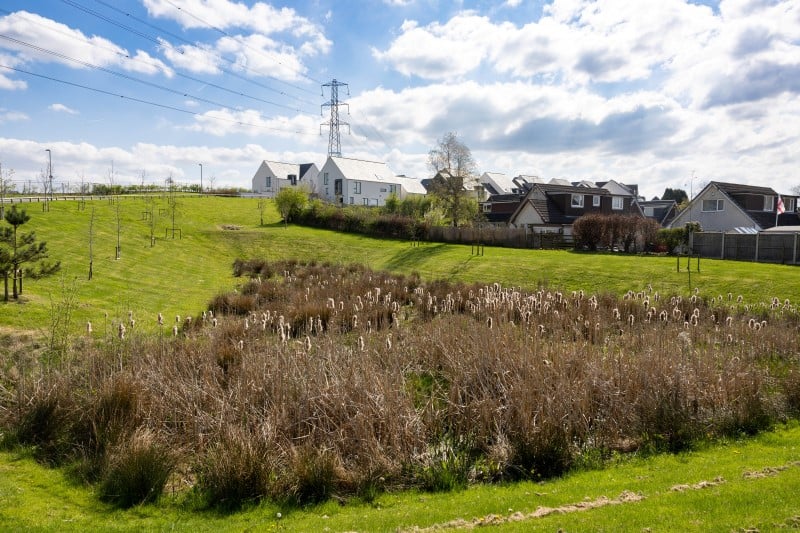01 Jul 2023
Nature-based approach helps relieve pressure on Cumbria’s water network

As housing needs grow and more developments pop up across the region, new ways of thinking have been key to protecting Cumbria from adverse weather events. Graham Morley, Strategy & Compliance Manager discusses recent partnership work to deliver Sustainable Drainage Systems (SuDS) across the region and the benefits they bring.
What work has been done to encourage the use of Sustainable Drainage Systems (SuDS) in Cumbria?
A partnership with leading housebuilder, Story Homes, has yielded remarkable progress in the implementation of Sustainable Drainage Systems (SuDS). The recent collaboration aimed to enhance the resilience of communities against flooding, safeguard water quality, and preserve the environment. By combining our expertise, we have championed sustainable practices in the construction industry and paved the way for a more sustainable future.
Our first two SuDS systems were built by Story Homes at developments in Carlisle and Wetheral and feature systems which store excess rainwater and allow it to soakaway naturally. As well as creating attractive green spaces, these also help increase local biodiversity.
What are SuDS and what do they do?
SuDS offer an innovative and environmentally friendly approach to managing surface water runoff in urban areas. Cumbria, a region renowned for its stunning landscapes and natural beauty, faces unique challenges related to flooding due to its hilly terrain and heavy rainfall. The employment of SuDS removes extra pressure from an already strained network.
SuDS systems, on the other hand, imitate nature's water management processes by allowing water to infiltrate into the ground, reducing flood risks, and minimising pollution, thus safeguarding Cumbria's natural resources.
SuDS can include:
- Permeable paving, which can be used on driveways and roads to help water be absorbed more easily
- Soakaways and other infiltration devices, meaning that no surface water runoff leaves the site
- Swales, shallow grassed or vegetated channels used to collect and/or move water, and basins, areas of land where all flowing surface water converges to a single point such as a wetland
- Bioretention/rain gardens providing a natural way to soak up excess water
- Green or sedum roofs, which encourage biodiversity alongside acting as a natural flood defence.
- Living/Green Walls, help absorb surface water
- Rainwater re-use, through the use of smart water butts
- Infiltration trenches and filter drains, which allow water to soak and filter through to a subsoil layer
What are the benefits?
The successful partnership brings a multitude of benefits specifically tailored to enhance Cumbria's resilience. The integration of SuDS systems into housing developments enables effective management of surface water runoff, reducing flood risks and protecting local communities.
As well as easing pressure on the sewer network, managing rainwater creatively through sustainable drainage supports nature in urban spaces, improves visual amenity, creates natural habitats, and benefits wildlife.
When new housing estates are planned in this way, they are not adding to the pressure on existing assets but also actively enhancing the environment through dedicated green spaces and homes for local ecology.
Why Story Homes?
We have long recognised the importance of mitigating flood risks and ensuring the long-term sustainability of water resources in Cumbria. Story Homes shares that vision and have demonstrated a commitment to addressing the specific challenges faced by the region.
We provided a consultation on the most appropriate SuDS before Story Homes delivered the solutions as part of the development. The asset is then handed back to us to maintain as part of the wider sewage and water management system.
We’ve offered incentives to those who build homes for several years, what’s different here?
Across the region, 58,000 homes that feature measures to divert rainwater away from the sewer network have either been already built or are in construction. Now we are ramping up our efforts working with developers from the outset of projects to ensure the SuDS they build can be adopted onto our network.
Instead of just offering incentives, we worked with Story Homes very early in the development stage. First of all, you’ve got to provide the space for SuDS and it’s hugely beneficial to have them developed into plans from the outset. If you develop it into your concept designs early on and you get all your stakeholders involved in those discussions, it doesn’t become a challenge it becomes part of the scheme itself.
Due to this early intervention, we’ve worked together to come up with something that both parties are happy with. We’ll be taking over an asset we’ve been involved in the design of, and which has a long-term management plan in place.
What’s the advantage of partnership working?
The partnership emphasises community engagement and awareness, fostering a sense of ownership and understanding among residents regarding the benefits of SuDS systems. By involving the local community in the planning and implementation process, the partnership aims to inspire long-term behavioural changes, promoting sustainable lifestyles and responsible water management practices.
The collaboration also promotes knowledge sharing and innovation, fostering the adoption of sustainable construction practices throughout the region. This holistic approach ensures that the positive impacts of SuDS systems extend beyond the housing developments, contributing to a more resilient and sustainable future for all across the Lake District.
What do you hope for the future?
It is our hope that other house builders will see the benefits of partnering with us early on in the development process. Given the successes we have seen with Story Homes it holds the potential to inspire other stakeholders within the construction industry to adopt sustainable practices.
The partnership in Cumbria exemplifies a transformative approach to sustainable construction. By prioritising the region's resilience and leveraging the benefits of SuDS, this collaboration not only mitigates flood risks but safeguards water quality and works towards a healthier, greener future for the Lake District.